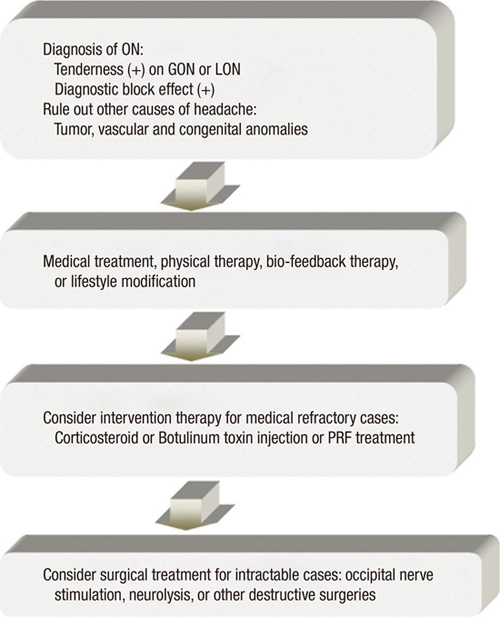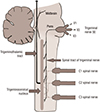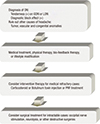1. Headache Classification Subcommittee of the International Headache Society. The International Classification of Headache Disorders: 2nd edition. Cephalalgia. 2004; 24:Suppl 1. 9–160.
2. Hammond SR, Danta G. Occipital neuralgia. Clin Exp Neurol. 1978; 15:258–270.
3. Koopman JS, Dieleman JP, Huygen FJ, de Mos M, Martin CG, Sturkenboom MC. Incidence of facial pain in the general population. Pain. 2009; 147:122–127.
4. Cohen SP, Plunkett AR, Wilkinson I, Nguyen C, Kurihara C, Flagg A 2nd, Morlando B, Stone C, White RL, Anderson-Barnes VC, et al. Headaches during war: analysis of presentation, treatment, and factors associated with outcome. Cephalalgia. 2012; 32:94–108.
5. Magnússon T, Ragnarsson T, Björnsson A. Occipital nerve release in patients with whiplash trauma and occipital neuralgia. Headache. 1996; 36:32–36.
6. Mason JO 3rd, Katz B, Greene HH. Severe ocular pain secondary to occipital neuralgia following vitrectomy surgery. Retina. 2004; 24:458–459.
7. Kuhn WF, Kuhn SC, Gilberstadt H. Occipital neuralgias: clinical recognition of a complicated headache. A case series and literature review. J Orofac Pain. 1997; 11:158–165.
8. Perelson HN. Occipital nerve tenderness; a sign of headache. South Med J. 1947; 40:653–656.
9. Vanelderen P, Lataster A, Levy R, Mekhail N, van Kleef M, Van Zundert J. 8. Occipital neuralgia. Pain Pract. 2010; 10:137–144.
10. Tobin J, Flitman S. Occipital nerve blocks: when and what to inject? Headache. 2009; 49:1521–1533.
11. Bogduk N. The clinical anatomy of the cervical dorsal rami. Spine. 1982; 7:319–330.
12. Rifat SF, Lombardo JA. Occipital neuralgia in a football player: a case report. Clin J Sport Med. 1995; 5:251–253.
13. Mosser SW, Guyuron B, Janis JE, Rohrich RJ. The anatomy of the greater occipital nerve: implications for the etiology of migraine headaches. Plast Reconstr Surg. 2004; 113:693–697.
14. Inan N, Ceyhan A, Inan L, Kavaklioglu O, Alptekin A, Unal N. C2/C3 nerve blocks and greater occipital nerve block in cervicogenic headache treatment. Funct Neurol. 2001; 16:239–243.
15. Dash KS, Janis JE, Guyuron B. The lesser and third occipital nerves and migraine headaches. Plast Reconstr Surg. 2005; 115:1752–1758.
16. Natsis K, Baraliakos X, Appell HJ, Tsikaras P, Gigis I, Koebke J. The course of the greater occipital nerve in the suboccipital region: a proposal for setting landmarks for local anesthesia in patients with occipital neuralgia. Clin Anat. 2006; 19:332–336.
17. Becser N, Bovim G, Sjaastad O. Extracranial nerves in the posterior part of the head. Anatomic variations and their possible clinical significance. Spine. 1998; 23:1435–1441.
18. Tubbs RS, Salter EG, Wellons JC, Blount JP, Oakes WJ. Landmarks for the identification of the cutaneous nerves of the occiput and nuchal regions. Clin Anat. 2007; 20:235–238.
19. Hollinshead WH. Anatomy for Surgeons. New York, NY: Harper & Row;1969.
20. Bogduk N, Marsland A. On the concept of third occipital headache. J Neurol Neurosurg Psychiatry. 1986; 49:775–780.
21. Dubuisson D. Treatment of occipital neuralgia by partial posterior rhizotomy at C1-3. J Neurosurg. 1995; 82:581–586.
22. Bogduk N. Cervicogenic headache: anatomic basis and pathophysiologic mechanisms. Curr Pain Headache Rep. 2001; 5:382–386.
23. Le Doaré K, Akerman S, Holland PR, Lasalandra MP, Bergerot A, Classey JD, Knight YE, Goadsby PJ. Occipital afferent activation of second order neurons in the trigeminocervical complex in rat. Neurosci Lett. 2006; 403:73–77.
24. Piovesan EJ, Kowacs PA, Tatsui CE, Lange MC, Ribas LC, Werneck LC. Referred pain after painful stimulation of the greater occipital nerve in humans: evidence of convergence of cervical afferences on trigeminal nuclei. Cephalalgia. 2001; 21:107–109.
25. Vital JM, Grenier F, Dautheribes M, Baspeyre H, Lavignolle B, Sénégas J. An anatomic and dynamic study of the greater occipital nerve (n. of Arnold). Applications to the treatment of Arnold’s neuralgia. Surg Radiol Anat. 1989; 11:205–210.
26. Ashkenazi A, Levin M. Three common neuralgias. How to manage trigeminal, occipital, and postherpetic pain. Postgrad Med. 2004; 116:16–18.
27. Loukas M, El-Sedfy A, Tubbs RS, Louis RG Jr, Wartmann CH, Curry B, Jordan R. Identification of greater occipital nerve landmarks for the treatment of occipital neuralgia. Folia Morphol (Warsz). 2006; 65:337–342.
28. Handel T, Kaplan R. Occipital neuralgia. In : Frontera WR, Silver JK, editors. Essentials of Physical Medicine and Rehabilitation. Philadelphia, PA: Hanley and Belfus;2002.
29. Beruto LJ, Ramos MM. Decades de med y cirug pract. Madrid. 1821; 3:145–169.
30. Trescot AM. Headache management in an interventional pain practice. Pain Physician. 2000; 3:197–200.
31. Martelletti P. Proinflammatory pathways in cervicogenic headache. Clin Exp Rheumatol. 2000; 18:S33–8.
32. Martelletti P, van Suijlekom H. Cervicogenic headache: practical approaches to therapy. CNS Drugs. 2004; 18:793–805.
33. Anthony M. Headache and the greater occipital nerve. Clin Neurol Neurosurg. 1992; 94:297–301.
34. Tsui JK, Eisen A, Stoessl AJ, Calne S, Calne DB. Double-blind study of botulinum toxin in spasmodic torticollis. Lancet. 1986; 2:245–247.
35. Binder WJ, Brin MF, Blitzer A, Schoenrock LD, Pogoda JM. Botulinum toxin type A (BOTOX) for treatment of migraine headaches: an open-label study. Otolaryngol Head Neck Surg. 2000; 123:669–676.
36. Welch MJ, Purkiss JR, Foster KA. Sensitivity of embryonic rat dorsal root ganglia neurons to Clostridium botulinum neurotoxins. Toxicon. 2000; 38:245–258.
37. Durham PL, Cady R, Cady R. Regulation of calcitonin gene-related peptide secretion from trigeminal nerve cells by botulinum toxin type A: implications for migraine therapy. Headache. 2004; 44:35–42.
38. Cui M, Khanijou S, Rubino J, Aoki KR. Subcutaneous administration of botulinum toxin A reduces formalin-induced pain. Pain. 2004; 107:125–133.
39. Harden RN, Cottrill J, Gagnon CM, Smitherman TA, Weinland SR, Tann B, Joseph P, Lee TS, Houle TT. Botulinum toxin a in the treatment of chronic tension-type headache with cervical myofascial trigger points: a randomized, double-blind, placebo-controlled pilot study. Headache. 2009; 49:732–743.
40. Wheeler AH. Botulinum toxin A, adjunctive therapy for refractory headaches associated with pericranial muscle tension. Headache. 1998; 38:468–471.
41. Zlotnik G. Re: “Botulinum toxin type A as a migraine preventive treatment” (Silberstein S, Mathew N, Saper J, Jenkins S, for the BOTOX Migraine Clinical Research Group. Headache. 2000;40:445-450). Headache. 2001; 41:606–607.
42. Taylor M, Silva S, Cottrell C. Botulinum toxin type-A (BOTOX) in the treatment of occipital neuralgia: a pilot study. Headache. 2008; 48:1476–1481.
43. Kapural L, Stillman M, Kapural M, McIntyre P, Guirgius M, Mekhail N. Botulinum toxin occipital nerve block for the treatment of severe occipital neuralgia: a case series. Pain Pract. 2007; 7:337–340.
44. Chua NH, Vissers KC, Sluijter ME. Pulsed radiofrequency treatment in interventional pain management: mechanisms and potential indications-a review. Acta Neurochir (Wien). 2011; 153:763–771.
45. Hagiwara S, Iwasaka H, Takeshima N, Noguchi T. Mechanisms of analgesic action of pulsed radiofrequency on adjuvant-induced pain in the rat: roles of descending adrenergic and serotonergic systems. Eur J Pain. 2009; 13:249–252.
46. Navani A, Mahajan G, Kreis P, Fishman SM. A case of pulsed radiofrequency lesioning for occipital neuralgia. Pain Med. 2006; 7:453–456.
47. Choi HJ, Oh IH, Choi SK, Lim YJ. Clinical outcomes of pulsed radiofrequency neuromodulation for the treatment of occipital neuralgia. J Korean Neurosurg Soc. 2012; 51:281–285.
48. Huang JH, Galvagno SM Jr, Hameed M, Wilkinson I, Erdek MA, Patel A, Buckenmaier C 3rd, Rosenberg J, Cohen SP. Occipital nerve pulsed radiofrequency treatment: a multi-center study evaluating predictors of outcome. Pain Med. 2012; 13:489–497.
49. Vanelderen P, Rouwette T, De Vooght P, Puylaert M, Heylen R, Vissers K, Van Zundert J. Pulsed radiofrequency for the treatment of occipital neuralgia: a prospective study with 6 months of follow-up. Reg Anesth Pain Med. 2010; 35:148–151.
50. Poletti CE. Proposed operation for occipital neuralgia: C-2 and C-3 root decompression. Case report. Neurosurgery. 1983; 12:221–224.
51. Bovim G, Fredriksen TA, Stolt-Nielsen A, Sjaastad O. Neurolysis of the greater occipital nerve in cervicogenic headache. A follow up study. Headache. 1992; 32:175–179.
52. Gille O, Lavignolle B, Vital JM. Surgical treatment of greater occipital neuralgia by neurolysis of the greater occipital nerve and sectioning of the inferior oblique muscle. Spine. 2004; 29:828–832.
53. Guyuron B, Kriegler JS, Davis J, Amini SB. Comprehensive surgical treatment of migraine headaches. Plast Reconstr Surg. 2005; 115:1–9.
54. Ducic I, Hartmann EC, Larson EE. Indications and outcomes for surgical treatment of patients with chronic migraine headaches caused by occipital neuralgia. Plast Reconstr Surg. 2009; 123:1453–1461.
55. Stechison MT, Mullin BB. Surgical treatment of greater occipital neuralgia: an appraisal of strategies. Acta Neurochir (Wien). 1994; 131:236–240.
56. Wang MY, Levi AD. Ganglionectomy of C-2 for the treatment of medically refractory occipital neuralgia. Neurosurg Focus. 2002; 12:E14.
57. Kapoor V, Rothfus WE, Grahovac SZ, Amin Kassam SZ, Horowitz MB. Refractory occipital neuralgia: preoperative assessment with CT-guided nerve block prior to dorsal cervical rhizotomy. AJNR Am J Neuroradiol. 2003; 24:2105–2110.
58. Slavin KV, Nersesyan H, Wess C. Peripheral neurostimulation for treatment of intractable occipital neuralgia. Neurosurgery. 2006; 58:112–119.
59. Goadsby PJ, Knight YE, Hoskin KL. Stimulation of the greater occipital nerve increases metabolic activity in the trigeminal nucleus caudalis and cervical dorsal horn of the cat. Pain. 1997; 73:23–28.
60. Okuda Y, Matsumoto T, Shinohara M, Kitajima T, Kim P. Sudden unconsciousness during a lesser occipital nerve block in a patient with the occipital bone defect. Eur J Anaesthesiol. 2001; 18:829–832.
61. Leinisch-Dahlke E, Jürgens T, Bogdahn U, Jakob W, May A. Greater occipital nerve block is ineffective in chronic tension type headache. Cephalalgia. 2005; 25:704–708.
62. Afridi SK, Shields KG, Bhola R, Goadsby PJ. Greater occipital nerve injection in primary headache syndromes--prolonged effects from a single injection. Pain. 2006; 122:126–129.
63. Naja ZM, El-Rajab M, Al-Tannir MA, Ziade FM, Tawfik OM. Repetitive occipital nerve blockade for cervicogenic headache: expanded case report of 47 adults. Pain Pract. 2006; 6:278–284.
64. Weiner RL, Reed KL. Peripheral neurostimulation for control of intractable occipital neuralgia. Neuromodulation. 1999; 2:217–221.
65. Johnstone CS, Sundaraj R. Occipital nerve stimulation for the treatment of occipital neuralgia-eight case studies. Neuromodulation. 2006; 9:41–47.
66. Oh MY, Ortega J, Bellotte JB, Whiting DM, Alo K. Peripheral nerve stimulation for the treatment of occipital neuralgia and transformed migraine using a c1-2-3 subcutaneous paddle style electrode: a technical report. Neuromodulation. 2004; 7:103–112.
67. Kapural L, Mekhail N, Hayek SM, Stanton-Hicks M, Malak O. Occipital nerve electrical stimulation via the midline approach and subcutaneous surgical leads for treatment of severe occipital neuralgia: a pilot study. Anesth Analg. 2005; 101:171–174.
68. Jasper JF, Hayek SM. Implanted occipital nerve stimulators. Pain Physician. 2008; 11:187–200.
69. White JB, Atkinson PP, Cloft HJ, Atkinson JL. Vascular compression as a potential cause of occipital neuralgia: a case report. Cephalalgia. 2008; 28:78–82.
70. Hashiguchi A, Mimata C, Ichimura H, Kuratsu J. Occipital neuralgia as a presenting symptom of cervicomedullary dural arteriovenous fistula. Headache. 2007; 47:1095–1097.
71. Bruti G, Mostardini C, Pierallini A, Villani V, Modini C, Cerbo R. Neurovascular headache and occipital neuralgia secondary to bleeding of bulbocervical cavernoma. Cephalalgia. 2007; 27:1074–1079.
72. Cerrato P, Bergui M, Imperiale D, Baima C, Grasso M, Giraudo M, Lentini A, Lopiano L, Bradac GB, Bergamasco B. Occipital neuralgia as isolated symptom of an upper cervical cavernous angioma. J Neurol. 2002; 249:1464–1465.
73. Pfadenhauer K, Weber H. Giant cell arteritis of the occipital arteries--a prospective color coded duplex sonography study in 78 patients. J Neurol. 2003; 250:844–849.
74. González-Gay MA, García-Porrúa C, Brañas F, Alba-Losada J. Giant cell arteritis presenting as occipital neuralgia. Clin Exp Rheumatol. 2001; 19:479.
75. Jundt JW, Mock D. Temporal arteritis with normal erythrocyte sedimentation rates presenting as occipital neuralgia. Arthritis Rheum. 1991; 34:217–219.
76. Kim K, Mizunari T, Kobayashi S, Ishii S, Teramoto A. Occipital neuralgia caused by the compression of the fenestrated vertebral artery: a case report. No Shinkei Geka. 1999; 27:645–650.
77. Sharma RR, Parekh HC, Prabhu S, Gurusinghe NT, Bertolis G. Compression of the C-2 root by a rare anomalous ectatic vertebral artery. Case report. J Neurosurg. 1993; 78:669–672.
78. Garza I. Craniocervical junction schwannoma mimicking occipital neuralgia. Headache. 2007; 47:1204–1205.
79. Ballesteros-Del Rio B, Ares-Luque A, Tejada-Garcia J, Muela-Molinero A. Occipital (Arnold) neuralgia secondary to greater occipital nerve schwannoma. Headache. 2003; 43:804–807.
80. Boes CJ. C2 myelitis presenting with neuralgiform occipital pain. Neurology. 2005; 64:1093–1094.
81. De Santi L, Monti L, Menci E, Bellini M, Annunziata P. Clinical-radiologic heterogeneity of occipital neuralgiform pain as multiple sclerosis relapse. Headache. 2009; 49:304–307.
82. Tancredi A, Caputi F. Greater occipital neuralgia and arthrosis of C1-2 lateral joint. Eur J Neurol. 2004; 11:573–574.
83. Postacchini F, Giannicola G, Cinotti G. Recovery of motor deficits after microdiscectomy for lumbar disc herniation. J Bone Joint Surg Br. 2002; 84:1040–1045.
84. Baer-Henney S, Tatagiba M, Samii M. Osteochondroma of the cervical spine causing occipital nerve neuralgia. Case report. Neurol Res. 2001; 23:777–779.
85. Piovesan EJ, Werneck LC, Kowacs PA, Tatsui C, Lange MC, Carraro Júnior H, Wittig EO. Greater occipital neuralgia associated with occipital osteolytic lesion. Case report. Arq Neuropsiquiatr. 1999; 57:114–119.
86. Clavel M, Clavel P. Occipital neuralgia secondary to exuberant callus formation. Case report. J Neurosurg. 1996; 85:1170–1171.
87. Volcy M, Tepper SJ, Rapoport AM, Sheftell FD, Bigal ME. Botulinum toxin A for the treatment of greater occipital neuralgia and trigeminal neuralgia: a case report with pathophysiological considerations. Cephalalgia. 2006; 26:336–340.
88. Picaza JA, Hunter SE, Cannon BW. Pain suppression by peripheral nerve stimulation. Chronic effects of implanted devices. Appl Neurophysiol. 1977-1978; 40:223–234.
89. Rodrigo-Royo MD, Azcona JM, Quero J, Lorente MC, Acín P, Azcona J. Peripheral neurostimulation in the management of cervicogenic headache: four case reports. Neuromodulation. 2005; 8:241–248.
90. Sharma RR, Devadas RV, Pawar SJ, Lad SD, Mahapatra AK. Current status of peripheral neurectomy for occipital neuralgia. Neurosurg Q. 2005; 15:232–238.
91. Tubbs RS, Mortazavi MM, Loukas M, D’Antoni AV, Shoja MM, Cohen-Gadol AA. Cruveilhier plexus: an anatomical study and a potential cause of failed treatments for occipital neuralgia and muscular and facet denervation procedures. J Neurosurg. 2011; 115:929–933.










 PDF
PDF ePub
ePub Citation
Citation Print
Print






 XML Download
XML Download